saddlebum66
Supreme Citizen of ZV
They work to an extent.Make sure you vaccuum and wash pet bedding regularly.The collar seems 2b the most healthy an effective treatment(Healthy pup of course) ….
They work to an extent.Make sure you vaccuum and wash pet bedding regularly.The collar seems 2b the most healthy an effective treatment(Healthy pup of course) ….
Same problem. I think you have the smaller ticks with the mottled whire marking center of shell, which would be dog ticks which are terrible this year.So, all of a sudden the ticks are quite bad. Over the last week I've killed probably ten of them on my boy. I'm hesitant to get a systemic antiparasitic medication or a chemical collar. And you can't just ask the vet 'oh by the way, will this make the cum im guzzling from this dog toxic?' One of the sprays at a local pet shop says that if it gets on an article of clothing, that clothing is 'contaminated'. If it's that bad, why the hell would I put it on the dog? Wouldn't the dog then be 'contaminated'? He's next to my skin just like clothing.
Surely there has to be a good option that doesn't make contact with the animal toxic, or his semen toxic (or taste of chemicals)? What are you guys doing? I've heard those chemical collars can cause burns on the skin, and I recall the ones we used on our cats stunk like crazy.
Deer ticks carry lyme. Dogs ticks scarlet feverAlSame problem. I think you have the smaller ticks with the mottled whire marking center of shell, which would be dog ticks which are terrible this year.
Nope. Scarlet Fever is bacterial, spreads from person to person. ROCKY MOUNTAIN SPOTTED FEVER is tick borne, anaplasmosis, borellia, and six or eight others are as well.Deer ticks carry lyme. Dogs ticks scarlet fever
You are right. Got my wires crossedNope. Scarlet Fever is bacterial, spreads from person to person. ROCKY MOUNTAIN SPOTTED FEVER, is tick borne, anaplasmosis, borellia, and six or eight others are as well.
Lyme Disease and Other Diseases Carried by Ticks
It's important for you and your family to be tick free!www.health.ny.gov
has the known list including powassan, the newest threat
Ticks with light mottlef markings are probably lone star ticks
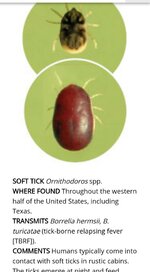
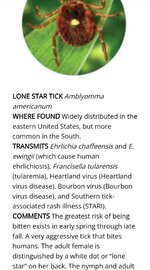
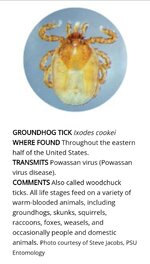
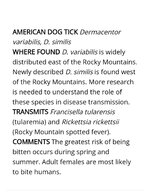
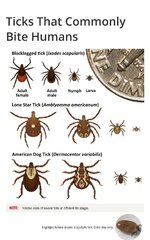
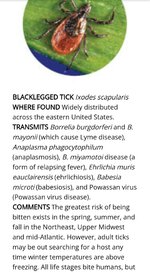
Same problem. I think you have the smaller ticks with the mottled whire marking center of shell, which would be dog ticks which are terrible this year.
Ticks with light mottlef markings are probably lone star ticks
Is it just that you wish to argue or do you have another agenda?
Giving these people more than they will bother digesting is a waste of time. I included a link which offers all they need to know IF they can be bothered reading. Arguing with me is a waste of yours. Enjoy your day.
Usually where their vector critters csrry them....ixodes species are vectored by birds, mice and deer in that order....Others may have different host-chains, but if birds are one, the worst places are around feeders or plants like sunflower and thistle which offer food.And also I got a question, what's the place with the most ticks ? The farms ?
Got it....sometimes its hard to tell.Not sure if this is directed at me, if so, my intent isn't to argue, just sharing information and clarifying things as I understand them. None of us (myself included) are experts at everything and I reply to you because you add useful information and I'm just trying to add more when I have it. If that upsets you, Im sorry as it has never been my intent and if you ask me to I'll stop as my intent is not to be a dick or to harass you, it just seems you post into threads I also find interesting; perhaps that means I find what you say interesting as well.
I tend to look at threads as recepticles of information and discussion and I often find myself looking at old ones, here and elsewhre, and I presume others do too. I put the info here for those who do have an interest, it might not always be the person I'm replying to or even those active in the thread, but I reply to give context for what I'm adding.
I did once find a tick in the hollow under the jaw of a mare who had bit in. Obviously he got on her while she was grazing.Usually where their vector critters csrry them....ixodes species are vectored by birds, mice and deer in that order....Others may have different host-chains, but if birds are one, the worst places are around feeders or plants like sunflower and thistle which offer food.
Ticks usually DROP onto a target creature; their MO is usually to climb up a plant stem and wait til something warm and breathing comes along.They can sense C02 and body heat like a little guided missile ....once on a host, they will.make their way to a less accessible area, where the host cannot scratch, attach themselves and start sucking. They often have an anti-coagulant saliva thst keeps the blood flowing....this is how they pass diseases around.
Farm animals are too tall to be a target. Sheep are not, but ticks will have a difficult time with thick wool coats.
Or fell off a bird. Or a taller branchI did once find a tick in the hollow under the jaw of a mare who had bit in. Obviously he got on her while she was grazing.
